We’re talking about the Glock 26 and the Glock 43 going head to head in a face-off to see which comes out on top. They’re both small. Eminently concealable. Each is 9mm. Many folks have a tough time getting a real grip on either one.
So…which will it be?
What Shooters Want
The market drives the products that gun manufacturers put out. They don’t necessarily make what is best…they make what people want, for the most part. After all, they’re in the business of selling products. If they don’t make products that people like, then they go under financially.
The shooting market certainly does experience some interesting trends. Not long ago, shooters wanted the tiniest pistols possible, holding the most rounds that could conceivably be jammed into those tiny framed pistols. And manufacturers designed and produced them.
Now we see those same models of pistols that were once tiny growing larger. The “XL” models were introduced. Apparently, shooting those minuscule pistols wasn’t as much fun as people figured it would be.
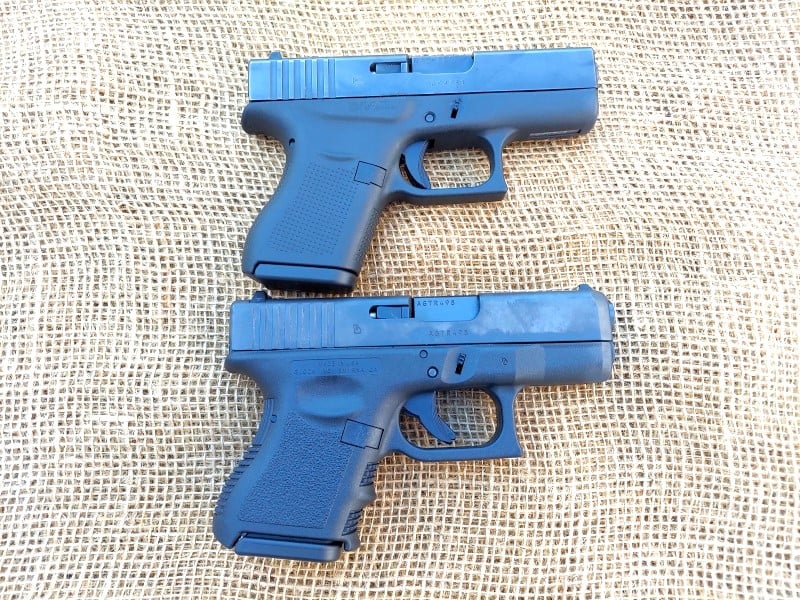
Sure, they’re nice to carry. However, when taken to the range and actually fired, they’re not always a barrel of fun to deal with. Tiny frames tend to transfer recoil into the hand. Read that as uncomfortable.
Those are the types of handguns that are typically carried a lot and shot a little. My Smith & Wesson 642 .38 Special revolver is a perfect example of that sort of handgun. It’s not especially endearing to shoot often.
The Glock 26
In 1994, Glock introduced the Glock 26. A “Baby” Glock in 9mm holding 10+1 rounds. Shooters had been clamoring for a smaller pistol than the Glock 19, and Glock gave them what they wanted, deeming it a “Sub-Compact.”
It is, in essence, a compact version of the Glock 19, which is a compact version of the Glock 17. You really can’t get any smaller than the Glock 26. Or can you? More on that shortly.
The barrel length on the Glock 26 is 3.43 inches, with the slide being 6.26 inches in length. The height of the Glock 26 is 4.17 inches.
It’s a thick pistol, at 1.26 inches wide. Actually, it’s about the same thickness as the Glock 19 and 17. Its smaller dimension seems to make it feel thicker.
The Glock 26’s grip is extremely short; even with my medium-sized hands, my pinkie finger hangs underneath the grip frame, dangling in space. Not being able to get a three-fingered grip on the pistol impedes my ability to shoot it well and maintain a strong grip.
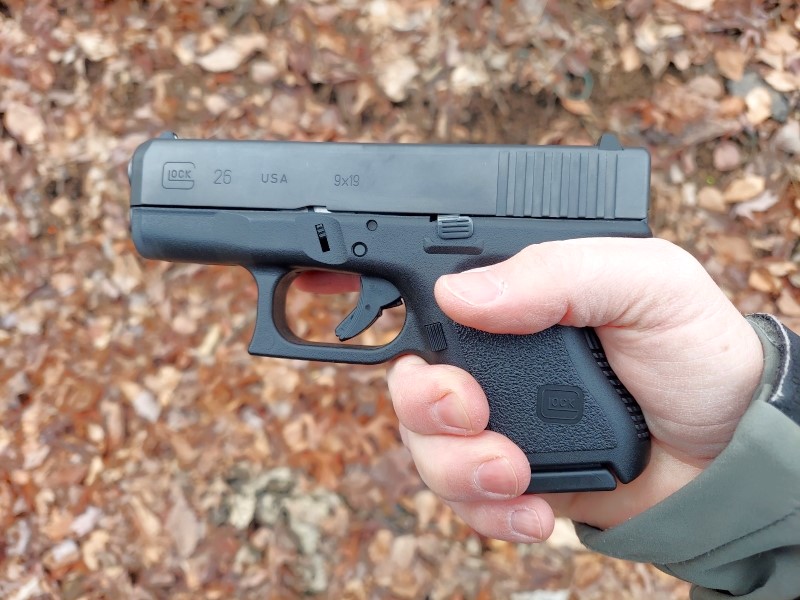
Because the Glock 26 is a double-stack 9mm magazine-fed pistol, it can also accept magazines from all the other Glock 9mm pistols that are double-stack. It will readily accept magazines from Glocks 19, 17, 19X, and all the rest that fit the bill. Magazines range in capacities from 10 rounds, 15, 17, 21, 31, all the way up to 33 rounds.
This makes it extremely appealing to people who carry the 26 because they can carry it with a standard magazine in place but have higher-capacity spare magazines along for the ride. It’s sure nice to have a 19-round Glock 19X magazine in a pouch or pocket as a spare in case real trouble comes knocking. If reloading in a firefight becomes necessary, I don’t know anyone who’s going to fret about losing concealability because they’ve shoved a 19-round magazine into the pistol. Those extra rounds can be a serious game-changer and a real comfort. As an aside, that extended magazine really helps the shooter get a good grip on the pistol, too.
The Interim
In 2014, Glock introduced the Glock 42, which is a .380 caliber pistol. Shooters had been yearning for a smaller alternative than even the Glock 26, and Glock delivered.
However, many people weren’t necessarily enamored with the prospect of the .380 cartridge. They wanted something more powerful and effective for defense.
Glock heard and listened.
The Glock 43
In 2015, the Glock 43 made its appearance on the scene. Shooters now had an honest 9mm pistol that is smaller than the Glock 26.
The Glock 43’s barrel length is 3.41 inches, with a slide length of 6.06 inches. Weight is an amazing 16.23 ounces. The overall width is 1.06 inches, which is pretty slim! The slide is even slimmer, at .87 inches. Make no mistake, this is a very small, concealable pistol.
Glock’s 43 is their first single-stack 9x19mm pistol. It utilizes a 6-round magazine, which allows the grip to be extremely thin (and to me, very comfortable). It’s very easy to get a hand around it. However, like the Glock 26, the grip is short.
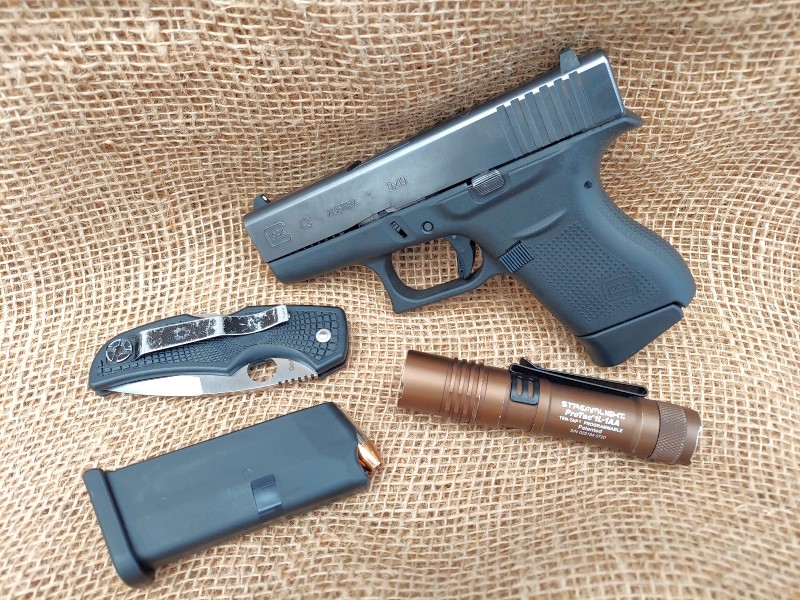
Glock has magazines that have extended baseplates so there is a landing zone for the shooter’s pinkie finger. I prefer these extended baseplate magazines by far.
There are also aftermarket extensions for magazines that raise the round count in magazines. This is in response to shooters who wanted more rounds than just six, which was a major criticism that people have of the little pistol.
Interestingly, some of those same shooters who are dissatisfied with 6+1 rounds of capacity with the Glock 43 used to carry 5-shot .38 Special snub-nosed revolvers.
The Glock 43 offers a few advantages over those revolvers. Namely, it carries two more rounds. And it’s faster to reload. Let’s face it, inserting a magazine into the 43 is faster than using a speed loader or speed strips to reload a revolver. And the Glock 43 is thinner than a revolver, so it is easier to carry.
The Mission
It’s a good idea to think about the mission that you’ll use your handgun for because it will help you to realistically arm yourself. What do you plan to carry the pistol for? The obvious answer is “Self-Defense” in most cases, which is a broad category.
When I was working for a company making beverage deliveries in bad areas of a major city, I carried a 5-shot .38 Special Snubby (S&W 642). It fit my needs at the time— a light, very concealable handgun. I figured five shots were enough because my mission wasn’t to take on several heavily armed gunmen. Rather, if I ran into trouble, it was to break contact and get out of Dodge. The revolver would allow me to do that. Similarly, so would the Glock 43.
Is the mission to protect my family and myself? Let’s say I’m at the grocery store and my family is a couple of aisles away from me and I hear gunshots ring out. Obviously, I’m not going to run from the store and leave my family to fend for themselves. I’m going to find them and get them to safety. In doing so, I might need to engage one or more armed bad guys. It’s a much different scenario than simply breaking contact and getting away from the danger. In such an instance, I might be glad to have more than seven rounds in my weapon.
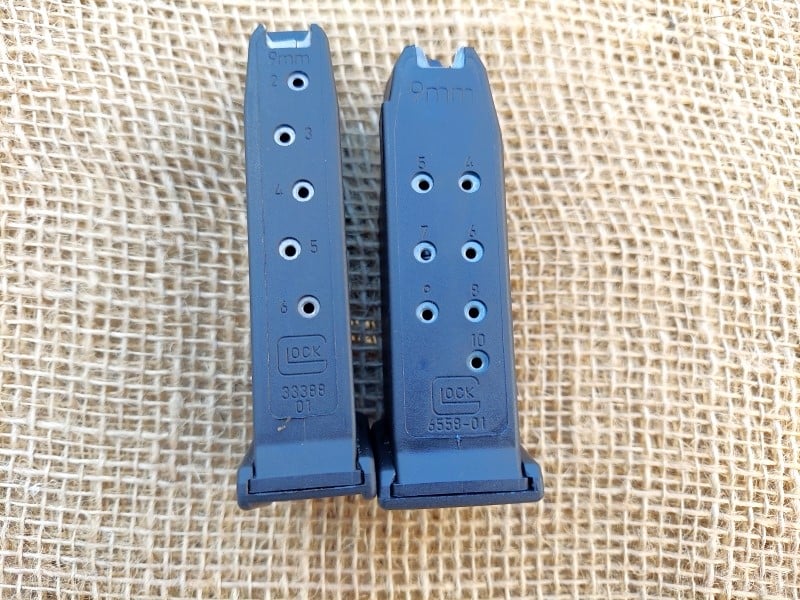
The Glock 26 carries four more rounds in the standard magazine than the Glock 43 does, which would be an advantage in a tactical scenario. Plus the G26 can carry spare magazines with higher capacity.
Some people use the smaller Glocks as backups to their larger weapons. Especially uniformed police officers. If they carry a Glock 19 as their primary weapon, a Glock 26 would make sense because the magazines of the G19 are interchangeable. And the manual of arms is also exactly the same, with the controls being mirrored in both pistols.
Convenience
The Glock 43 is thinner and lighter than the Glock 26, so it’s easier to carry. Sometimes, lighter and easier strikes my fancy. It’s as simple as that. It’s just a convenience thing, and at times, we like convenient things. Many will rationalize that it’s better to have a little gun than no gun at all. And hey, if carrying a convenient gun gets people to carry when they otherwise might not have, then we could look at that as a win, right?
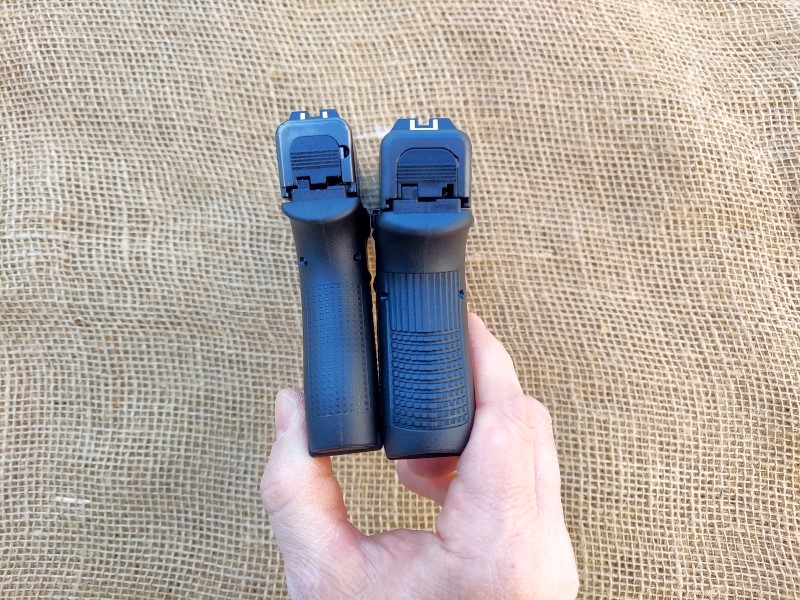
At The Range
Glock 26
On the firing range, the Glock 26 is an accurate pistol. We fired it mostly at 10 and 15 yards and groups were easy to keep centered. When using standard magazines, my pinkie finger had to curl underneath the base of the magazine because of the short grip, which was irritating. I much prefer a full grip on whichever pistol I happen to be shooting. This can be remedied with the addition of a magazine extension, so it’s a fixable issue.
Recoil on the Glock 26 was a little more pronounced than with its larger brother, the Glock 19. However, it was not a major issue at all. Glock does a nice job dampening the recoil with their double recoil spring, which does its job well. Follow-up shots were fast, as the sights returned to the target quickly.
Glock 43
The Glock 43’s recoil is more pronounced than that of the G26. Considering that it’s lighter and thinner, this comes as no shock. This recoil, however, is not anything that most people cannot handle. The sights still return to the target fairly quickly and rapid fire is certainly realistic.
When shooting the G43, I have a tendency to pull shots a little to the left, which can be frustrating. It’s not the pistol, it’s my technique that is at fault. The grip is smaller than I’m used to, so some practice will remedy this.
Accuracy is certainly good enough to engage bad guys at 20 yards and beyond.
One of the nice things about the Glock 43 is that it ships with a magazine that has an extended baseplate, so the pinkie finger has a spot to park. I wish all the magazines for the 43 would have that extension in place.
The Verdict
Personally, I like the Glock 43 a lot. Here’s why: I can get a better grip on it. It’s lighter and more comfortable to carry. It conceals a little better for me.
Does the smaller capacity bother me? A little, depending on circumstances. As long as I realize I’m compromising on the capacity when I carry it, I’m good with that.
The Glock 26 is a good shooter. The very short grip is not to my liking and would need a grip extension for the magazines (but then so does the 43, for that matter). It’s also a chunky pistol and seems even chunkier than it really is. The small size seems to emphasize the thickness.
If I were issued a Glock 26 and had to carry it, I’d feel well-armed. For the reasons mentioned, it’s just not my personal first choice for carry.
Both are solid pistols and you will have to make up your mind as to which is best.


